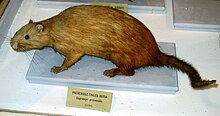Prehensile-tailed hutia
| Prehensile-tailed hutia | |
|---|---|

| |
| Scientific classification | |
| Kingdom: | Animalia |
| Phylum: | Chordata |
| Class: | Mammalia |
| Order: | Rodentia |
| Family: | Echimyidae |
| Tribe: | Capromyini |
| Genus: | Mysateles Lesson, 1842 |
| Species: | M. prehensilis
|
| Binomial name | |
| Mysateles prehensilis (Poeppig, 1824)
| |
| Subspecies | |
|
M. p. gundlachi (Chapman, 1901) | |
The prehensile-tailed hutia (Mysateles prehensilis) is a species of hutia in the subfamily Capromyinae endemic to Cuba. It is the only member of the genus Mysateles. It is an arboreal foliovore, found in both primary and secondary forest.[1]
Taxonomy[]
The genus name Mysateles derives from the two ancient greek words μῦς (mûs), meaning "mouse, rat", and ἀτέλεια (atéleia), meaning "incomplete, imperfect".
Within Capromyidae, the closest relative of Mysateles is the genus Mesocapromys. Both genera are the sister group to Capromys, and then Geocapromys is a more distant genus. In turn, these four genera belong to the tribe Capromyini, and are the sister group to Plagiodontia.
| Genus-level cladogram of the Capromyidae with their relationship to Carterodon and Euryzygomatomyinae. | |||||||||||||||||||||||||||||||||||||||||||||||||||||
| |||||||||||||||||||||||||||||||||||||||||||||||||||||
| The cladogram has been reconstructed from mitochondrial and nuclear DNA characters.[2][3][4][5][6][7] |
Several other hutia species such as Garrido's hutia (Capromys garridoi) and the black-tailed hutia (Mesocapromys melanurus) were formerly classified in Mysateles, but phylogenetic evidence found them to belong in different genera, leaving only M. prehensilis in Mysateles.[8]
A subspecies, Mysateles prehensilis gundlachi (also known as Chapman's prehensile-tailed hutia or Gundlach's hutia) was previously considered a separate species (Mysateles gundlachi).[9] The Isla De La Juventud tree hutia (M. p. meridionalis) was also previously considered a separate species, but was found to be a subspecies by phylogenetic studies.[8][10]
Genetics[]
Its karyotype has 2n = 34 and FN = 54–56.[11]
Conservation[]
The species is listed as near threatened on the IUCN Red List. Although locally common in some areas, it is in decline and is threatened by deforestation and habitat fragmentation.[1]
References[]
- ^ a b c Soy, J.; Silva, G. (2008). "Mysateles prehensilis". IUCN Red List of Threatened Species. 2008: e.T14258A4427189. doi:10.2305/IUCN.UK.2008.RLTS.T14258A4427189.en. Retrieved 16 November 2021.
- ^ Galewski, Thomas; Mauffrey, Jean-François; Leite, Yuri L. R.; Patton, James L.; Douzery, Emmanuel J. P. (2005). "Ecomorphological diversification among South American spiny rats (Rodentia; Echimyidae): a phylogenetic and chronological approach". Molecular Phylogenetics and Evolution. 34 (3): 601–615. doi:10.1016/j.ympev.2004.11.015. PMID 15683932.
- ^ Upham, Nathan S.; Patterson, Bruce D. (2012). "Diversification and biogeography of the Neotropical caviomorph lineage Octodontoidea (Rodentia: Hystricognathi)". Molecular Phylogenetics and Evolution. 63 (2): 417–429. doi:10.1016/j.ympev.2012.01.020. PMID 22327013.
- ^ Fabre, Pierre-Henri; Galewski, Thomas; Tilak, Marie-ka; Douzery, Emmanuel J. P. (2013-03-01). "Diversification of South American spiny rats (Echimyidae): a multigene phylogenetic approach". Zoologica Scripta. 42 (2): 117–134. doi:10.1111/j.1463-6409.2012.00572.x. ISSN 1463-6409.
- ^ Fabre, Pierre-Henri; Vilstrup, Julia T.; Raghavan, Maanasa; Der Sarkissian, Clio; Willerslev, Eske; Douzery, Emmanuel J. P.; Orlando, Ludovic (2014-07-01). "Rodents of the Caribbean: origin and diversification of hutias unravelled by next-generation museomics". Biology Letters. 10 (7): 20140266. doi:10.1098/rsbl.2014.0266. ISSN 1744-9561. PMC 4126619. PMID 25115033.
- ^ Upham, Nathan S.; Patterson, Bruce D. (2015). "Evolution of Caviomorph rodents: a complete phylogeny and timetree for living genera". In Vassallo, Aldo Ivan; Antenucci, Daniel (eds.). Biology of caviomorph rodents: diversity and evolution. Buenos Aires: SAREM Series A, Mammalogical Research — Sociedad Argentina para el Estudio de los Mamíferos. pp. 63–120.
- ^ Fabre, Pierre-Henri; Upham, Nathan S.; Emmons, Louise H.; Justy, Fabienne; Leite, Yuri L. R.; Loss, Ana Carolina; Orlando, Ludovic; Tilak, Marie-Ka; Patterson, Bruce D.; Douzery, Emmanuel J. P. (2017-03-01). "Mitogenomic Phylogeny, Diversification, and Biogeography of South American Spiny Rats". Molecular Biology and Evolution. 34 (3): 613–633. doi:10.1093/molbev/msw261. ISSN 0737-4038. PMID 28025278.
- ^ a b Turvey, Samuel T; Kennerley, Rosalind J; Nuñez-Miño, Jose M; Young, Richard P (2017-07-29). "The Last Survivors: current status and conservation of the non-volant land mammals of the insular Caribbean". Journal of Mammalogy. 98 (4): 918–936. doi:10.1093/jmammal/gyw154. ISSN 0022-2372.
- ^ "Mysateles gundlachi (Chapman, 1901)". ITIS.
- ^ "Explore the Database". www.mammaldiversity.org. Retrieved 2021-10-02.
- ^ Woods, C.A.; Kilpatrick, C.W. (2005). "Infraorder Hystricognathi". In Wilson, D.E.; Reeder, D.M (eds.). Mammal Species of the World: A Taxonomic and Geographic Reference (3rd ed.). Johns Hopkins University Press. p. 1597. ISBN 978-0-8018-8221-0. OCLC 62265494.
- IUCN Red List near threatened species
- Mysateles
- Endemic fauna of Cuba
- Mammals of Cuba
- Mammals of the Caribbean
- Near threatened animals
- Mammals described in 1824
- Taxa named by Eduard Friedrich Poeppig
- Rodent stubs
